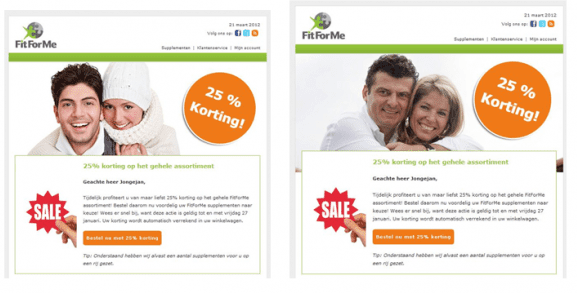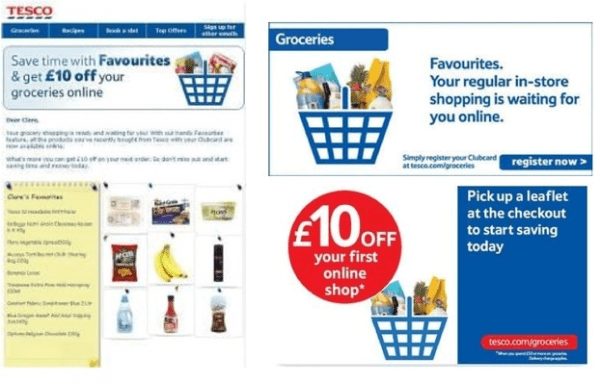7 simple and effective ways to use email segmentation
A database filled with a lot of quality data offers many possibilities. The best way to send an email is to send one that's personal and completely adjusted to fit the needs, interests, and (buying) behaviour. And more relevant email campaigns means a better shot at more opens and clicks.
In this blog post, I'll show you different options to segment your customer database, enabling you to better target each customer.
7 ways to segment your email lists
One of the more obvious ways to segment your email campaigns: do you want to target men or women? When creating your email templates, try to design a template which is able to switch content based on the variable 'gender'.
Adjust the images in your campaigns to appeal to men as soon as you are targeting the men in your marketing database. The same can be done for the ladies.
Seems fairly easy, right? This segmentation example illustrates that you can set up a targeted and more relevant email campaign based on just one bit of information.
- 2. Content based on location
The rise of mobile marketing makes it ever more interesting to segment your email campaigns based on address and location.
Not only does it enable you to send them targeted and relevant offers for them to enjoy in their surroundings, but when you combine online shopping with offline stores, you can set up email (or mobile) campaigns highlighting interesting offers in stores close to your customers’ homes.
Or if they placed an order in your webshop, why not suggest they pick it up in the nearest store. Again this shows you don't need to have a lot of data to create efficient segments in your database and target your customers with personal and relevant information.
Next to the usual data such as email address or address data, it might be interesting to ask your (potential) customers to share their date of birth. Based on this information you can decide if you want to adjust the tone of voice in your emails or adjust the images you use (like the example below).

For example, be more polite in emails towards your recipients older than 40 or use more 'slang' towards your younger readers. And this bit of information allows for triggering birthday mails too.
- 4. Using triggers from your website
When you are a webshop owner, it is possible to store data coming from your webshop in your database and use it to trigger email campaigns. Triggered messages a a great way to help you engage with your customers without effort.
For example, targeting customers who placed products in a shopping cart but did not complete the purchase. This can be caused by several reasons.
You might know of abandoned shopping cart campaigns. It has already been proven that such email campaigns generate better results. Customers targeted with this kind of emails show an increase in revenue of up to 55%!. From the same research and from our own experience with our users, we know it's best to send these type of campaigns quite quickly. Bu at least within 24 hours after abandonment.
So try segmenting your users based on the orders they've left in your shopping carts and if it turns out they haven't completed the purchase within 24 hours, trigger the email campaign targeted toward that specific target group.
Let's dig a little deeper now. Say you store the purchase data from your customers. You can use data from previous purchases to adjust the content of your mailings or to add relevant offers.
For example, you could set up campaigns reminding your customers to supplement their previous webshop purchase.
A simple example: a customer bought a Gillette razor set with 5 razor blades in your webshop. Based on your experience with other customers, you might know that it takes an average man three to four weeks to finish the five blades. So you segment these buyers in a specific target group and target them with a campaign reminding them to buy some new razor blades.
Another good example of this kind of emails is provided by Tesco. They personalised their email campaign to registered Clubcard customers by using data gathered from previous online and in-store shopping behaviour.

This type of segmentation helps you inform your customers in a timely manner and with a relevant offer, you enabling them to easily place a new order in your webshop.
- 6. Time of a last purchase
Registering this kind of product information will make it possible for you to apply segmentation based on 'inactive' customers. This means you create a target group that hasn't been active in your webshop for a while.
Try targeting customers who haven't purchased anything during the past six months. Chances are that if they've purchased one or more items in your webshop before this period of absence, they'll start purchasing in your webshop again. This way you can actively try to re-engage the inactive in your database.
- 7. By interests and needs
Try to get to know your customer. By adding a 'my-profile'-section to your website, where a customer can share his brand preferences, interests and store other relevant data. As soon as you gather more knowledge about your customers' lifestyle, you can create segments in your database based on this data.
For example, you own a fashion webshop and in your 'my-profile'-section your customers can indicate brand preferences for brands such as Nike, Adidas, McGregor, etc... Based on that data, you can create a segment for each brand and send out targeted campaigns to your customers whenever there are special discounts for these specific brands.
Another way for you to gather knowledge on brand preferences or lifestyle is by analyzing previous purchases of your clients, like Amazon does in their email marketing, these could show a specific pattern that could indicate a certain interest or brand preference. But this takes a lot longer than simply asking your customers.
Add structure to your database with segmentation
In Summary
In email marketing it is crucial you develop a contact strategy. What are the specific contact moments for your target group? What interests do they have that match your product range? How can you set up those email campaigns triggered by your customer behavior? Of course it is easiest to start with an inspection of the segmentation data you already have in your database.
Based on this kind of information, it's crucial you set up an extensive and segmented database with up-to-date customer data that is well structured. This database enables you to set up the segmented email campaigns we mentioned. The more specific the information about your target group, the better you can target your customers.
Centralized database
By managing the data in one centralized database, all of your reports and data from your campaigns stay in one place. That enables you to easily analyze and compare reports of different email campaigns.
The more extensive your database (the more specific data you've gathered for each target group), the better you can communicate with your target group. With the help of a well-maintained and centralized database it's easier to target your customers with relevant messages and marketing campaigns. And there are many ways to use segmentation.

Thanks to Michael Linthorst for sharing his thoughts in this post. He is an internet entrepreneur and CEO of Copernica BV.
Copernica is powerful marketing software for email marketing, web pages, mobile and automated campaigns. More than 3.500 users successfully use Copernica Marketing Software on a daily basis. Connect with Michael on
LinkedIn or
Twitter.





 Thanks to Michael Linthorst for sharing his thoughts in this post. He is an internet entrepreneur and CEO of Copernica BV.
Thanks to Michael Linthorst for sharing his thoughts in this post. He is an internet entrepreneur and CEO of Copernica BV. 


